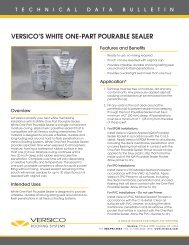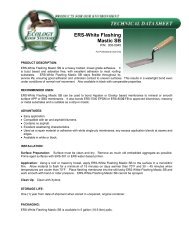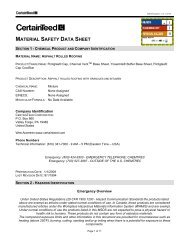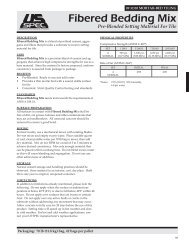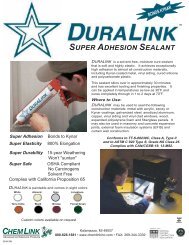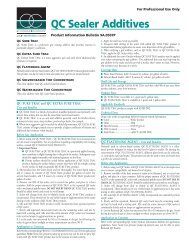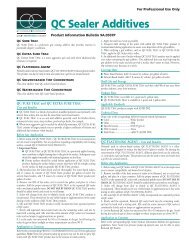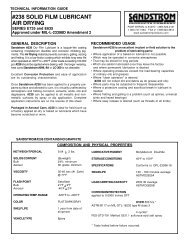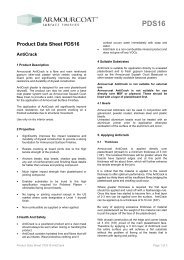Simpson Anchors - Anchoring and Fastening Systems - BuildSite.com
Simpson Anchors - Anchoring and Fastening Systems - BuildSite.com
Simpson Anchors - Anchoring and Fastening Systems - BuildSite.com
You also want an ePaper? Increase the reach of your titles
YUMPU automatically turns print PDFs into web optimized ePapers that Google loves.
20<br />
TREATMENT OF DESIGN METHODS UNDER MODEL BUILDING CODES<br />
Structural Post-Installed Anchor Design Methods Permitted by Building Codes<br />
Building Code Base Material<br />
2006 IBC/IRC<br />
2003 IBC/IRC<br />
2000 IBC/IRC<br />
1997 UBC<br />
Traditional<br />
ASD<br />
Permitted Design Methods 3<br />
ACI 318<br />
App. D/<br />
ICC-ES AC193<br />
ICC-ES<br />
AC308<br />
Concrete 1 No Yes Yes<br />
Masonry 2 Yes N/A 4 N/A 4<br />
Concrete 1 No Yes Yes<br />
Masonry 2 Yes N/A 4 N/A 4<br />
Concrete 1 Yes Yes Yes<br />
Masonry 2 Yes N/A 4 N/A 4<br />
Concrete 1 Yes Yes Yes<br />
Masonry 2 Yes N/A 4 N/A 4<br />
1. “Concrete” includes all concrete base materials such as concrete on metal deck <strong>and</strong> precast concrete shapes.<br />
2. “Masonry” includes all masonry base materials such as hollow <strong>and</strong> grout-filled CMU <strong>and</strong> unreinforced brick masonry.<br />
3. Code interpretations vary. Confirm with the local Building Official.<br />
4. Not applicable since masonry is beyond the scope of this design method.<br />
Building codes <strong>and</strong> material st<strong>and</strong>ards have traditionally allowed Designers to take a one third allowablestress<br />
increase on the calculated design capacities of some building materials <strong>and</strong> <strong>com</strong>ponents when<br />
designing for forces generated from wind <strong>and</strong>/or seismic events. Newer codes <strong>and</strong> st<strong>and</strong>ards only allow<br />
the allowable stress increase to be taken when using an alternate set of load <strong>com</strong>binations. The table below<br />
summarizes when allowable-stress increases are permitted.<br />
1/3 Allowable-Stress Increase for Structural Post-Installed <strong>Anchors</strong><br />
Building Code Base Material<br />
2006 IBC/IRC<br />
2003 IBC/IRC<br />
2000 IBC/IRC<br />
1997 UBC<br />
Is 1/3 Allowable Stress Increase Permitted for Post-<br />
Installed <strong>Anchors</strong> Designed with Traditional ASD?<br />
Concrete 1 N/A 3<br />
Masonry 2 Yes 4<br />
Concrete 1 N/A 3<br />
Masonry 2 Yes 4<br />
Concrete 1 Yes 4<br />
Masonry 2 Yes 4<br />
Concrete 1 Yes 4<br />
Masonry 2 Yes 4<br />
1. “Concrete” includes all concrete base materials such as reinforced concrete, concrete on metal deck <strong>and</strong><br />
precast concrete shapes.<br />
2. “Masonry” includes all masonry base materials such as hollow <strong>and</strong> grout-filled CMU <strong>and</strong> unreinforced clay-brick masonry.<br />
3. Not applicable since this code does not use traditional ASD for post-installed anchors.<br />
4. Only when indicated in the applicable load table in this catalog <strong>and</strong> when alternative basic load <strong>com</strong>binations as prescribed<br />
in the code are used.<br />
C-SAS-2009 © 2009 SIMPSON STRONG-TIE COMPANY INC.



